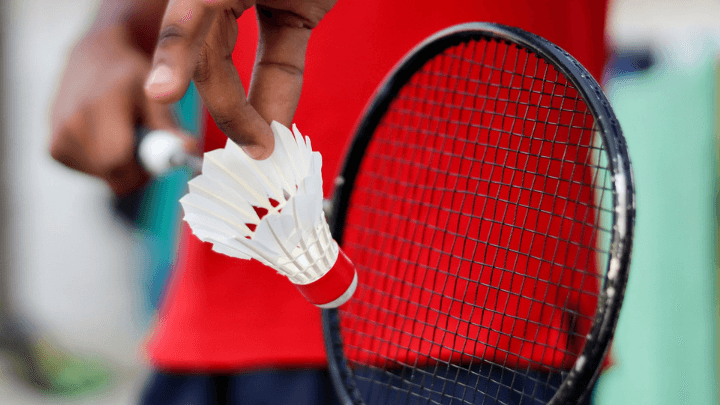Your style of play determines how thick your badminton grip should be. If you enjoy a power game, a thicker racket grip will suit you better. Conversely, if you are a more technical player, then it would be wise to opt for a thinner racket grip.
A thicker racket grip will allow you to hold the racket more tightly and apply more power to your shots. A thinner grip, meanwhile, will allow your fingers to stay flexible, providing you with more superior control to aim the shots where you see fit.
Veteran players might thus prefer a thick grip as they already have supreme control over their shots. Having a racket that adds just that bit of power to their shot will give them a slight edge over competitors solely relying on techniques. Beginners, meanwhile, might want to opt for a thinner grip.
Let’s discuss everything badminton grip-related.
Thin Grip Vs. Thick Grip
Thin Grip
A thin grip suits players with a deceptive playing style.
It gives your fingers more control over the racket’s head’s movement, letting you aim shots wherever on the court you see fit.
The type of shot that is better suited to a thin grip includes overhead clears, drop shots, netplay, and deceptive shots.
If you want better control, make sure the racket’s handle is heavier than the racket head. That’s because a head-heavy racket is difficult to maneuver with a thin grip.
Keep in mind that playing with a thin grip means receiving more feedback from the racket. As there isn’t enough cushioning on the handle to absorb vibrations being transferred from the racket head.
Thick Grip
A thick grip is ideal for players with a power attacking style.
By letting you hold the racket more tightly, it allows you to impart all the power you can muster to your shots.
The kind of shots that are best played with a thick grip include jump smashes, drives, net pushes, and attacking overhead shots.
You can add even more power to your shots by combining a thick grip with a head-heavy racket. A head-heavy racket adds momentum to the swing, letting you hit the shuttlecock more ferociously than before.
That said, by opting for a thicker grip, you’re giving away at least some of the control over your shots. So be prepared to see a few of your smashes landing outside the court.
What is G1 – G5 Grip Size In Badminton?
The alphabet “G” is used to denote grip size of badminton rackets. Almost all racket manufacturers offer 4 or 5 grip sizes indicated by G1, G2, G3, G4, and G5. Here is what these grip sizes mean:
-
-
- G1 — 3.7 inches
- G2 — 3.6 inches
- G3 — 3.5 inches
- G4 — 3.3 inches
- G5 — 3.1 inches
-
Does Grip Size Matter In Badminton?
Grip size doesn’t matter as much in badminton as most people think. That is because it is your style of play that determines the best grip size for you, and not the other way around.
Power players will choose a larger grip because it allows them to impart more power to their smashes, whereas a thin grip will give you more control over your shots.
So the grip size you are using doesn’t make you a better or worse player than those using a different grip size.
How to Measure a Badminton Grip?
Here’s how you should measure a badminton grip size:
- Wrap your hitting hand around the grip (eastern grip)
- Place the index finger of your non-hitting hand in the space between the palm of your hand holding the racket and the wrapped three fingers.
- If there isn’t enough space for the index finger, the grip is too small. If there is space, the grip is too big.
Badminton Grip FAQs
1. How To Make Badminton Grip Smaller?
Shave the wooden handle to make the badminton grip smaller. You can sand by hand or with a power sander. Some players also use a router to cut the wooden handle down to their preferred size.
2. How To Make Badminton Grip Bigger?
You can use cushioned grip tape to make a badminton grip bigger. Just wrap the tape around the handle until the grip size is according to your preference.
The balance will change slightly — the racket will get a little bottom-heavy — but it won’t affect your game much.
3. What Is The Smallest Grip Size In Badminton?
G5 is the smallest grip size in badminton. A G5 grip measures 3.5 inches in circumference, though grip sizes vary slightly from manufacturer to manufacturer.
4. Can You Use Tennis Grip For Badminton?
You can certainly use a tennis grip for badminton. In fact, tennis grips can also come in handy for other sports such as pickleball, squash, and even racketball.
5. Should Badminton Grips be Thick or Thin?
The thickness of badminton grips is a matter of personal preference. A thick grip suits those players who enjoy a power game. A thin grip comes in handy for badminton players who opt for technique over power.
6. How often should a badminton grip be changed?
A durable badminton grip should be changed every 7 to 10 days.
This is to ensure best hygiene practices and performance. However, if you are using a cheap/inexpensive grip, it should be replaced every 4 sessions of a badminton game.
Conclusion
A right size badminton grip helps you hold the racket correctly, supplements your wrist motion and makes it easy for you to maneuver the racket.
This enables it to improve all aspects of your game, letting you move ahead of those whose racket grip doesn’t complement their style of play.
Now I want to hear from you:
- Do you prefer a thick or thin badminton grip?
- What is your grip size?
- Ever experimented with other grip sizes?
Feel free to reach out to me in the comments section below, I’d love to answer your questions and hear your feedback. We are also on Instagram @healthyprinciples_.







